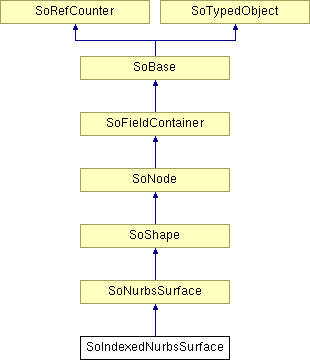SoIndexedNurbsSurface Class Reference
[Shapes]
Indexed NURBS surface shape node. More...
#include <Inventor/nodes/SoIndexedNurbsSurface.h>

Public Member Functions | |
| virtual SoType | getTypeId () const |
| SoIndexedNurbsSurface () | |
Static Public Member Functions | |
| static SoType | getClassTypeId () |
Public Attributes | |
| SoMFInt32 | coordIndex |
| SoMFInt32 | textureCoordIndex |
Detailed Description
Indexed NURBS surface shape node.
This shape node represents a NURBS surface based on the knot vectors and the control points that you specify. The uKnotVector and vKnotVector fields specify floating-point arrays of values; the values are the coordinates of the knot points in the surface, and you must enter them in non-decreasing order. The numUControlPoints and numVControlPoints fields specify the number of control points the surface will have in the U and V parametric directions, and will use the current coordinates that are indexed from the coordIndex field.
You can get a surface of minimum order (2) in the U or V directions by specifying two more knots than control points in that direction and having at least two control points in that direction. This surface would appear creased in one direction.
You can get a surface of maximum order (8) in the U or V directions by specifying eight more knots than control points in that direction and having at least eight control points in that direction.
The control points of the NURBS surface are transformed by the current cumulative transformation. The surface is drawn with the current light model and drawing style. The coordinates, normals, and texture coordinates of a surface are generated, so you cannot bind explicit normals or texture coordinates to a NURBS surface. The first material in the state is applied to the entire surface.
The surface is trimmed according to the currently defined profiles curves.
When default texture coordinates are applied to a NURBS surface, the edges of the texture square are stretched to fit the surface. The axes of the texture are called S and T; S is horizontal and T is vertical. The axes of the NURBS surface are called U and V; U is horizontal and V is vertical. You can also define texture coordinates explicitly with the S,T location point, the knot vectors, and the current texture coordinates.
NOTE:
- The fields textureCoordIndex, numSControlPoints, numTControlPoints, sKnotVector and tKnotVector are not used.
FILE FORMAT/DEFAULT
- IndexedNurbsSurface {
| numUControlPoints | 0 |
| numVControlPoints | 0 |
| numSControlPoints | 0 |
| numTControlPoints | 0 |
| coordIndex | 0 |
| uKnotVector | 0 |
| vKnotVector | 0 |
| sKnotVector | 0 |
| tKnotVector | 0 |
| textureCoordIndex | -1 |
ACTION BEHAVIOR
- SoGLRenderAction
Draws the surface based on the current coordinates, material, and so on.
SoRayPickAction
Picks the surface based on the current coordinates and transformation.
SoGetBoundingBoxAction
Computes the bounding box that encloses all control points of the surface with the current transformation applied to them. Sets the center to the average of the control points.
SoCallbackAction
If any triangle callbacks are registered with the action, they will be invoked for each successive triangle approximating the surface.
SEE ALSO
SoFullSceneAntialiasing, SoIndexedNurbsCurve, SoNurbsSurface, SoProfile
Constructor & Destructor Documentation
| SoIndexedNurbsSurface::SoIndexedNurbsSurface | ( | ) |
Creates an indexed NURBS surface node with default settings.
Member Function Documentation
| static SoType SoIndexedNurbsSurface::getClassTypeId | ( | ) | [static] |
Returns the type identifier for this class.
Reimplemented from SoNurbsSurface.
| virtual SoType SoIndexedNurbsSurface::getTypeId | ( | ) | const [virtual] |
Returns the type identifier for this specific instance.
Reimplemented from SoNurbsSurface.
Member Data Documentation
Coordinate indices.
Texture coordinate indices.
Not used.
The documentation for this class was generated from the following file:
- Inventor/nodes/SoIndexedNurbsSurface.h